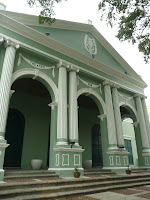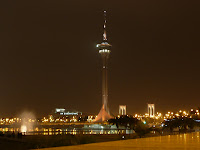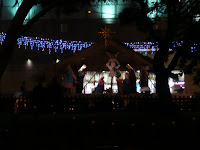On New Year’s Day my friend took us on another day trip to Macau. Even though it’s pretty customary to visit Macau whenever I’m back in Hong Kong, there’s still a good part of Macau that I’ve never set foot upon.
元旦日,我的朋友兼領隊安排澳門一日遊。雖說差不多每次回港都會到澳門逛逛,但其實有很多地方我都從沒認真看過。
We went directly to Taipa to start our tour around Macau. I remember a long time ago that Taipa was one of the two outlying islands of Macau, the other being Coloane. But these days the two islands become joined after reclamation, and the newly created land becomes home to a cluster of brand new casinos and hotels. Our first stop is the Venetian Resort Hotel, which is one of those casinos located on this so-called Cotai Strip. After a brief walk through the hotel, we went into the town centre of Taipa (Vila da Taipa) to look for a restaurant serving local style Portuguese cuisine, but we were out of luck as the shop has already folded. We could only go on to find another one.
我們這次出發時直往氹仔,祇記得很久之前氹仔和路環仍是分開兩個島,但現在因填海而連成一整片,填海區不少地方都建了簇新的賭場和酒店,真可謂滄海桑田了。我們先到填海區氹仔金光大道的威尼斯人賭場,在裡面兜了個圈,然後往氹仔市區,按旅遊書找推介的澳葡餐廳,但原來結了業,祇好隨便找另一家餐廳了。

Rows of motorcycles are a common sight in Macau
澳門隨處可見的摩托車陣

The Four-Faced Buddha at Estrada Govenador Albano Oliveira
位於柯維納馬路的四面佛


Rotunda do Estadio (left) and Macau Stadium (right)
運動場圓形地(左)及澳門運動場(右)
After the meal, we sauntered along the streets nearby. The traditional architecture and bright colours of the buildings as well as the lamp posts with hanging flower pots gave the whole area a distinctive and lively look.
飯後在附近的街道閒逛,一路不少房屋都保留了獨特的建築風格而且色彩鮮豔,電燈柱也掛了感開花兒的花盤,令整個地區生氣盅然。

Vila da Taipa
氹仔市區

Pak Tai Temple on Rua do Regedor
北帝廟

Rua Correia da Silva and its pretty buildings
告利雅施利華街及沿街別緻的樓房



There are a lot of tasty roadside snacks and food everywhere in Macau, and of course one of our missions was to try as many of them as possible. We deliberately had a light lunch and planned to have dinner as late as possible to give ourselves more time and stomach space to digest them all! Unfortunately we had to give Portuguese tarts a miss because we couldn’t be bothered joining a very long queue. Instead we tried the ‘sawdust’ cake which was basically a piece of cake sprinkled with biscuit crumbs. We also bought some sweets and other snacks from a chain store that dotted the whole of Taipa.
澳門特色小食多,我們午飯時沒吃太多,又安排晚一點才吃晚飯,以便大家「掃街」(邊逛邊吃),我們在氹仔見人龍太長等不了吃葡撻,但吃過另一道甜點叫木糠蛋糕,其實是在表面灑了餅乾糠的蛋糕。我們又在一家開遍氹仔的糖果店,各自買了點手信。

Rua da Cunha - snacks and other food galore
食肆和零食店林立的官也街

A traditional bakery with its old-style shutter
舊式餅店的舊式鐵閘
Afterwards we took the bus to the Macau peninsula and went straight to Rua da Felicidade to try the street version shark fin soup. The tiny interior of the shop was totally filled up, and we thought it would be better to order take-away and eat in the street instead. It was of course more comfortable to eat without a crowd. Another drawing card for Rua da Felicidade was its historical buildings, including the row of white buildings with bright red wooden door and window frames, as well as an old-style residential blind alley.
之後乘車到澳門半島,把握第一時間到福隆新街一嚐碗仔翅,那家店子門面小,坐無虛設,我們一班人索性捧着一盒盒的碗仔翅坐在街邊吃,吃得比在裡面的人更舒服。福隆新街的另一個賣點,就是一街保存完好的青樓和那些獨特的鮮紅色窗框和門框,另有一條住滿了人的舊式小巷,令人好像走進了歷史中。


Traditional buildings along Rua da Felicidade
福隆新街的青樓


A side alley on Rua da Felicidade
福隆新街內的福榮里住滿了人
At one end of Rua da Felicidade was an uphill road that led to Largo de Santo Agostinho (St. Augustine’s Square) which offered us another piece of history altogether. The whole area offered a glimpse into the colonial era through the architecture and colours of Igreja de Santo Agostinho (St. Augustine’s Church) and Teatro Dom Pedro V (King Pedro V Theatre), the tranquility of the square as well as the roads paved with so many patterns using many irregular tiles.
在福隆新街的一端走上一道小斜坡,我們來到崗頂前地,那裡也有很濃的歷史氣息,聖奧斯丁教堂和崗頂劇院鮮明的顏色和建築,氣氛悠閒的廣場,和用碎片鋪出不同圖案的行人路,都有很明顯的殖民地色彩。(我不敢說是葡萄牙色彩,是因為同行有個朋友說崗頂劇院的建築用料和結構有別於一般葡萄牙建築,我還沒到過那裡就不懂鑑別了。)



Interesting buildings along the Calçada do Gamboa
夜呣斜巷的特色建築


Largo de Santo Agostinho 崗頂前地

Igreja de Santo Agostinho
聖奧斯丁教堂


Teatro Dom Pedro V 崗頂劇院

Biblioteca Sir Robert Ho Tung
何東圖書館
Then we walked downhill, crossed the main thoroughfare Avenida de Almeida Ribeiro and visited the Cultural Club for the exhibition of Jin Yong, a famous Chinese novelist, and the tea house on the top floor.
然後我們走下山,橫過大馬路到文化會館,看看金庸展館和頂樓的茶居。

One of the typical narrow residential streets in Macau
從崗頂通往大馬路的東方斜巷

The entrance of the Cultural Club
文化會館入口


Jin Yong exhibition, including the original scripts for his novels (right)
金庸館的展品,包括作者本人手迹(右)

A traditional pawn shop exhibit adjoining the Cultural Club
文化會館相連有個舊式當鋪展覽
It’s time to eat again. We tried a couple of different congees and fried mud carp fish balls in a congee shop at Largo do Senado (Senate Square) before heading towards the Ruinas de São Paolo (Ruins of St. Paul’s), where the façade remained after the rest of the original cathedral was destroyed by a fire. At night the façade was surrounded by the bright neon lights from the nearby casinos, which our tour guide considered as a blight to this historical site and wondered if it would affect its listing as a UNESCO heritage. The alley leading up to the ruins was dotted with many snack shops. For some of us it meant time for more shopping, and for the others it was a chance to taste some beef jerky. I’ve almost forgotten how delicious a fresh chunky juicy beef jerky can be – as well as how filling it can be, as I felt there wasn’t much room left for dinner!
又是時候吃了,我們在議事庭前地的一家粥品店嚐過兩道粥和炸鯪魚球後,便往大三巴牌坊進發。晚上的大三巴,除了那個屹立不倒的教堂前璧外,環顧四周都看到新落成賭場的霓虹燈光,已成為大三巴景觀的一部分,友人笑說不知那會不會影響大三巴的世界文化遺產地位了。通往牌坊的大三巴街盡是不同的小食店,同行有些朋友忙着再添購手信,我和另一個朋友則買了些牛肉乾,趁新鮮吃,很久沒吃,一片片鮮紅的,又厚又嫩又多汁,當然滋味無窮,不過一次吃得太多,竟然有點影響到之後晚飯的胃口!


Christmas decorations on Largo do Senado 議事庭前地的聖誕裝飾

Chestnuts over a fiery roast
火光熊熊的鮮烤粟子


Ruinas de São Paolo (left) and the views from the ruins (right)
大三巴牌坊(左)和從牌坊回望的景色(右)
For dinner we had yet another meal of local style Portuguese food. Before we could get our table, another friend went with me for a quick stroll nearby. Before long the Torre de Macau (Macau Tower) was within our sights. Against the backdrop of the night sky, the brightly-lit tower and Ponte de Sai Van (Sai Van Bridge) easily dominated the scene.
晚飯光顧另一家澳葡菜,我和一個朋友趁等候時間到附近走一圈,走了才五分鐘便看到澳門旅遊塔,在海邊拔地而起,連同塔後發光的西灣大橋,構成一幅奪目的夜景。

Torre de Macau by night
澳門旅遊塔夜景

Gabineta da Secretária para a Administração e Justiça
(Office of the Administration and Justice Secretary)
行政法務司司長辦公室


An interesting office in the middle of Avenida Comercial (left), and Nativity scene in a park along Avenida da Praia Grande (right)
澳門商業大馬路上一個用途不詳的辦公室(左)和南灣大馬路某公園的耶穌降臨佈置(右)
After dinner it was already quite late. I parted with my friends at Porto Exterior where they returned to Hong Kong by ferry and I took a bus to the hotel adjoining the Macau Airport as I had a flight to catch the next morning. This Christmas trip was in fact made possible by a newly launched budget flight direct to Macau from Melbourne. It wasn’t too arduous a transit to Hong Kong. There was a pier right next to the airport, less than 10 minutes on foot (although the signage to the path could be improved). And once at the pier, it’s simply a matter of taking the next available ferry which runs every 1/2 hour to Hong Kong. In the end, the transit process wasn’t too time-consuming. I think the pier can help to uncover plenty of possible connections between Macau Airport and the Pearl River Delta region and help the Macau Airport to develop into a budget airport hub. (At least now there is a cheap alternative for travelling to Hong Kong even for peak seasons, and quite a few Hong Kongers were also spotted on the flights taking advantage of this like me.) Now the Macau government and the airport authority must work hard to turn this potential into a real success.
晚飯後時間已晚,朋友們都趕着乘船回港,我跟他們在外港碼頭道別後,便往與機場相連的酒店過一夜,以便翌日一早乘飛機回澳洲。其實這次我回港,有賴新開由墨爾本直飛澳門的廉價航班,原來這樣經澳門回港不太難,機場毗鄰氹仔臨時碼頭,從機場走到碼頭才不過十分鐘(雖然指示有點不足),來住香港和氹仔的船也每半小時開出一班,所以轉換交通的時間也不是花了太多。我覺得澳門機場結合了這個氹仔碼頭確實有發展潛力,作為香港和珠三角的廉航基地(起碼旺季回港也多個選擇,我乘坐的那班機也有不少香港人),不過能否成功,則有賴澳門政府和機場管理當局的造化了。

The newest casino in Macau, Oceanus
澳門最新賭場——海立方

Views on the strip of casinos near Porto Exterior
外港碼頭一帶的賭場

Hotel room with an airport view!
從酒店房間可飽覽澳門機場景色
元旦日,我的朋友兼領隊安排澳門一日遊。雖說差不多每次回港都會到澳門逛逛,但其實有很多地方我都從沒認真看過。
We went directly to Taipa to start our tour around Macau. I remember a long time ago that Taipa was one of the two outlying islands of Macau, the other being Coloane. But these days the two islands become joined after reclamation, and the newly created land becomes home to a cluster of brand new casinos and hotels. Our first stop is the Venetian Resort Hotel, which is one of those casinos located on this so-called Cotai Strip. After a brief walk through the hotel, we went into the town centre of Taipa (Vila da Taipa) to look for a restaurant serving local style Portuguese cuisine, but we were out of luck as the shop has already folded. We could only go on to find another one.
我們這次出發時直往氹仔,祇記得很久之前氹仔和路環仍是分開兩個島,但現在因填海而連成一整片,填海區不少地方都建了簇新的賭場和酒店,真可謂滄海桑田了。我們先到填海區氹仔金光大道的威尼斯人賭場,在裡面兜了個圈,然後往氹仔市區,按旅遊書找推介的澳葡餐廳,但原來結了業,祇好隨便找另一家餐廳了。

Rows of motorcycles are a common sight in Macau
澳門隨處可見的摩托車陣

The Four-Faced Buddha at Estrada Govenador Albano Oliveira
位於柯維納馬路的四面佛


Rotunda do Estadio (left) and Macau Stadium (right)
運動場圓形地(左)及澳門運動場(右)
After the meal, we sauntered along the streets nearby. The traditional architecture and bright colours of the buildings as well as the lamp posts with hanging flower pots gave the whole area a distinctive and lively look.
飯後在附近的街道閒逛,一路不少房屋都保留了獨特的建築風格而且色彩鮮豔,電燈柱也掛了感開花兒的花盤,令整個地區生氣盅然。

Vila da Taipa
氹仔市區

Pak Tai Temple on Rua do Regedor
北帝廟

Rua Correia da Silva and its pretty buildings
告利雅施利華街及沿街別緻的樓房



There are a lot of tasty roadside snacks and food everywhere in Macau, and of course one of our missions was to try as many of them as possible. We deliberately had a light lunch and planned to have dinner as late as possible to give ourselves more time and stomach space to digest them all! Unfortunately we had to give Portuguese tarts a miss because we couldn’t be bothered joining a very long queue. Instead we tried the ‘sawdust’ cake which was basically a piece of cake sprinkled with biscuit crumbs. We also bought some sweets and other snacks from a chain store that dotted the whole of Taipa.
澳門特色小食多,我們午飯時沒吃太多,又安排晚一點才吃晚飯,以便大家「掃街」(邊逛邊吃),我們在氹仔見人龍太長等不了吃葡撻,但吃過另一道甜點叫木糠蛋糕,其實是在表面灑了餅乾糠的蛋糕。我們又在一家開遍氹仔的糖果店,各自買了點手信。

Rua da Cunha - snacks and other food galore
食肆和零食店林立的官也街

A traditional bakery with its old-style shutter
舊式餅店的舊式鐵閘
Afterwards we took the bus to the Macau peninsula and went straight to Rua da Felicidade to try the street version shark fin soup. The tiny interior of the shop was totally filled up, and we thought it would be better to order take-away and eat in the street instead. It was of course more comfortable to eat without a crowd. Another drawing card for Rua da Felicidade was its historical buildings, including the row of white buildings with bright red wooden door and window frames, as well as an old-style residential blind alley.
之後乘車到澳門半島,把握第一時間到福隆新街一嚐碗仔翅,那家店子門面小,坐無虛設,我們一班人索性捧着一盒盒的碗仔翅坐在街邊吃,吃得比在裡面的人更舒服。福隆新街的另一個賣點,就是一街保存完好的青樓和那些獨特的鮮紅色窗框和門框,另有一條住滿了人的舊式小巷,令人好像走進了歷史中。


Traditional buildings along Rua da Felicidade
福隆新街的青樓


A side alley on Rua da Felicidade
福隆新街內的福榮里住滿了人
At one end of Rua da Felicidade was an uphill road that led to Largo de Santo Agostinho (St. Augustine’s Square) which offered us another piece of history altogether. The whole area offered a glimpse into the colonial era through the architecture and colours of Igreja de Santo Agostinho (St. Augustine’s Church) and Teatro Dom Pedro V (King Pedro V Theatre), the tranquility of the square as well as the roads paved with so many patterns using many irregular tiles.
在福隆新街的一端走上一道小斜坡,我們來到崗頂前地,那裡也有很濃的歷史氣息,聖奧斯丁教堂和崗頂劇院鮮明的顏色和建築,氣氛悠閒的廣場,和用碎片鋪出不同圖案的行人路,都有很明顯的殖民地色彩。(我不敢說是葡萄牙色彩,是因為同行有個朋友說崗頂劇院的建築用料和結構有別於一般葡萄牙建築,我還沒到過那裡就不懂鑑別了。)



Interesting buildings along the Calçada do Gamboa
夜呣斜巷的特色建築


Largo de Santo Agostinho 崗頂前地

Igreja de Santo Agostinho
聖奧斯丁教堂


Teatro Dom Pedro V 崗頂劇院

Biblioteca Sir Robert Ho Tung
何東圖書館
Then we walked downhill, crossed the main thoroughfare Avenida de Almeida Ribeiro and visited the Cultural Club for the exhibition of Jin Yong, a famous Chinese novelist, and the tea house on the top floor.
然後我們走下山,橫過大馬路到文化會館,看看金庸展館和頂樓的茶居。

One of the typical narrow residential streets in Macau
從崗頂通往大馬路的東方斜巷

The entrance of the Cultural Club
文化會館入口


Jin Yong exhibition, including the original scripts for his novels (right)
金庸館的展品,包括作者本人手迹(右)

A traditional pawn shop exhibit adjoining the Cultural Club
文化會館相連有個舊式當鋪展覽
It’s time to eat again. We tried a couple of different congees and fried mud carp fish balls in a congee shop at Largo do Senado (Senate Square) before heading towards the Ruinas de São Paolo (Ruins of St. Paul’s), where the façade remained after the rest of the original cathedral was destroyed by a fire. At night the façade was surrounded by the bright neon lights from the nearby casinos, which our tour guide considered as a blight to this historical site and wondered if it would affect its listing as a UNESCO heritage. The alley leading up to the ruins was dotted with many snack shops. For some of us it meant time for more shopping, and for the others it was a chance to taste some beef jerky. I’ve almost forgotten how delicious a fresh chunky juicy beef jerky can be – as well as how filling it can be, as I felt there wasn’t much room left for dinner!
又是時候吃了,我們在議事庭前地的一家粥品店嚐過兩道粥和炸鯪魚球後,便往大三巴牌坊進發。晚上的大三巴,除了那個屹立不倒的教堂前璧外,環顧四周都看到新落成賭場的霓虹燈光,已成為大三巴景觀的一部分,友人笑說不知那會不會影響大三巴的世界文化遺產地位了。通往牌坊的大三巴街盡是不同的小食店,同行有些朋友忙着再添購手信,我和另一個朋友則買了些牛肉乾,趁新鮮吃,很久沒吃,一片片鮮紅的,又厚又嫩又多汁,當然滋味無窮,不過一次吃得太多,竟然有點影響到之後晚飯的胃口!


Christmas decorations on Largo do Senado 議事庭前地的聖誕裝飾

Chestnuts over a fiery roast
火光熊熊的鮮烤粟子


Ruinas de São Paolo (left) and the views from the ruins (right)
大三巴牌坊(左)和從牌坊回望的景色(右)
For dinner we had yet another meal of local style Portuguese food. Before we could get our table, another friend went with me for a quick stroll nearby. Before long the Torre de Macau (Macau Tower) was within our sights. Against the backdrop of the night sky, the brightly-lit tower and Ponte de Sai Van (Sai Van Bridge) easily dominated the scene.
晚飯光顧另一家澳葡菜,我和一個朋友趁等候時間到附近走一圈,走了才五分鐘便看到澳門旅遊塔,在海邊拔地而起,連同塔後發光的西灣大橋,構成一幅奪目的夜景。

Torre de Macau by night
澳門旅遊塔夜景

Gabineta da Secretária para a Administração e Justiça
(Office of the Administration and Justice Secretary)
行政法務司司長辦公室


An interesting office in the middle of Avenida Comercial (left), and Nativity scene in a park along Avenida da Praia Grande (right)
澳門商業大馬路上一個用途不詳的辦公室(左)和南灣大馬路某公園的耶穌降臨佈置(右)
After dinner it was already quite late. I parted with my friends at Porto Exterior where they returned to Hong Kong by ferry and I took a bus to the hotel adjoining the Macau Airport as I had a flight to catch the next morning. This Christmas trip was in fact made possible by a newly launched budget flight direct to Macau from Melbourne. It wasn’t too arduous a transit to Hong Kong. There was a pier right next to the airport, less than 10 minutes on foot (although the signage to the path could be improved). And once at the pier, it’s simply a matter of taking the next available ferry which runs every 1/2 hour to Hong Kong. In the end, the transit process wasn’t too time-consuming. I think the pier can help to uncover plenty of possible connections between Macau Airport and the Pearl River Delta region and help the Macau Airport to develop into a budget airport hub. (At least now there is a cheap alternative for travelling to Hong Kong even for peak seasons, and quite a few Hong Kongers were also spotted on the flights taking advantage of this like me.) Now the Macau government and the airport authority must work hard to turn this potential into a real success.
晚飯後時間已晚,朋友們都趕着乘船回港,我跟他們在外港碼頭道別後,便往與機場相連的酒店過一夜,以便翌日一早乘飛機回澳洲。其實這次我回港,有賴新開由墨爾本直飛澳門的廉價航班,原來這樣經澳門回港不太難,機場毗鄰氹仔臨時碼頭,從機場走到碼頭才不過十分鐘(雖然指示有點不足),來住香港和氹仔的船也每半小時開出一班,所以轉換交通的時間也不是花了太多。我覺得澳門機場結合了這個氹仔碼頭確實有發展潛力,作為香港和珠三角的廉航基地(起碼旺季回港也多個選擇,我乘坐的那班機也有不少香港人),不過能否成功,則有賴澳門政府和機場管理當局的造化了。

The newest casino in Macau, Oceanus
澳門最新賭場——海立方

Views on the strip of casinos near Porto Exterior
外港碼頭一帶的賭場

Hotel room with an airport view!
從酒店房間可飽覽澳門機場景色
Comments